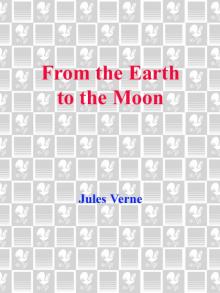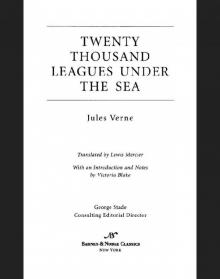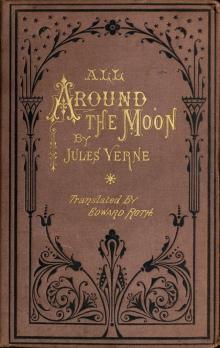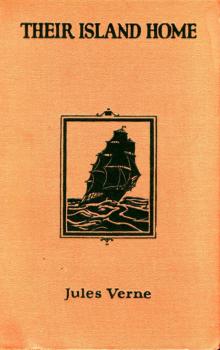- Home
- Jules Verne
From the Earth to the Moon Page 6
From the Earth to the Moon Read online
Page 6
“Then what will you do?” asked the general. “Give your projectile a diameter of sixty feet?”
“No.”
“Well, then, do you intend to make the moon brighter?”
“Yes, I do.”
“You can’t be serious!” cried J. T. Maston.
“It’s really quite simple,” said Barbicane. “If I succeed in diminishing the density of the atmosphere the moon’s light travels through, haven’t I, in effect, made its light brighter?”
“Of course.”
“Very well: to obtain that result, all that’s necessary is to place a telescope on a high mountain, and that’s what we’ll do.”
“I surrender!” said the major. “You have a way of simplifying things … And what magnification do you expect to get that way?”
“Forty-eight thousand. That will bring the moon to within five miles, and objects only nine feet wide will be visible.”
“Wonderful!” said J. T. Maston. “So our projectile will have a diameter of nine feet!”
“Exactly.”
“Allow me to point out, however,” said Major Elphiston, “that it will be so heavy that …”
“Before we discuss its weight, Major,” said Barbicane, “let me tell you that our ancestors performed wonders in that domain. Far be it from me to say that the science of ballistics hasn’t made progress, but we ought to realize that amazing results were obtained as long ago as the Middle Ages. I might even say that they were more amazing than ours.”
“That’s unbelievable!” said Morgan.
“Can you justify what you’ve said?” J. T. Maston asked sharply.
“Certainly,” replied Barbicane. “I have examples to support it. During the siege of Constantinople by Mohammed II, in 1543, stone projectiles were used that weighed 1,900 pounds and must have had impressive dimensions.”
“Ah,” said the major, “1,900 pounds is a good weight!”
“At Malta, in the days of the knights, a cannon in Fort St. Elmo shot projectiles weighing 2,500 pounds.”
“Incredible!”
“Finally, according to a French historian, in the reign of Louis XI a mortar shot a bombshell that weighed only five hundred pounds, but that bombshell went from the Bastille, a place where the insane imprisoned the sane, to Charenton, where the sane imprisoned the insane.”
“Very good!” said J. T. Maston.
“Since then, what have we done, really? The Armstrong cannon shoots a five-hundred-pound ball, the Rodman Columbiad a projectile weighing half a ton. It seems that what projectiles have gained in range, they’ve lost in weight. If we turn our efforts in that direction, we should be able, with the progress of science, to make cannon balls ten times as heavy as those of Mohammed II and the Knights of Malta.”
“That’s obvious,” said the major. “But what metal do you intend to use for our projectile?”
“Ordinary cast iron,” said General Morgan.
“Cast iron?” J. T. Maston said scornfully. “That’s too common for a projectile that’s going to the moon!”
“Let’s not exaggerate,” said Morgan. “Cast iron will be good enough.”
“Well, then,” said Major Elphiston, “since its weight will be proportional to its volume, a cast-iron ball nine feet in diameter will be fantastically heavy!”
“If it’s solid, yes; but not if it’s hollow,” said Barbicane.
“Hollow! Is it going to be a shell, rather than a ball?”
“We can put messages in it,” said J. T. Maston, “and samples of our production here on earth.”
“Yes, it will be a shell,” said Barbicane. “It must be; a nine-foot solid ball would weigh more than 200,000 pounds, and that’s obviously much too heavy. However, since the projectile must have a certain stability, I propose to give it a weight of 20,000 pounds.”
“How thick will its walls be?” asked the major.
“If we use standard proportions,” said Morgan, “a nine-foot diameter will require walls at least two feet thick.”
“That would be much too heavy,” said Barbicane. “You must bear in mind that we’re not designing a shell to pierce armor plate. Its walls need only be thick enough to withstand the pressure of the powder gases in the bore. So our problem is this: how thick must the walls of a cast-iron shell be if it’s to weigh only 20,000 pounds? I’m sure our skilled calculator, Mr. Maston, can tell us that immediately.”
“I’ll be glad to,” replied the honorable secretary of the committee.
He wrote a few algebraic formulas on a sheet of paper. Here and there he wrote a π or an x2. He even appeared to extract a certain cube root with the greatest of ease. Finally he said:
“The walls could be no more than two inches thick.”
“Would that be enough?” the major asked doubtfully.
“No, of course not,” replied Barbicane.
“Then what shall we do?” the major asked with a puzzled look.
“We’ll have to use some other metal than cast iron.”
“Copper?”
“No, that’s also too heavy. I have something better to suggest.”
“What is it?”
“Aluminum,” said Barbicane.
“Aluminum!” exclaimed his three colleagues.
“That’s right, my friends. As you know, in 1854 a famous French chemist, Henri Sainte-Claire-Deville, succeeded in obtaining aluminum in a compact mass. That precious metal is as white as silver, as unchanging as gold, as tough as iron, as fusible as copper, and as light as glass. It’s easily worked, it’s extremely widespread in nature, since alumina forms the base of most rocks, it has only a third of the weight of iron, and it seems to have been created for the specific purpose of providing us with material for our projectile!”
“Hurrah for aluminum!” cried J. T. Maston, who was always very noisy in his moments of enthusiasm.
“But isn’t aluminum very expensive to produce?” asked the major.
“It used to be,” replied Barbicane. “When it was first discovered, it cost somewhere between $260 and $280 a pound, then it dropped to $27, and now it’s down to $9.”
“But $9 a pound,” said the major, who did not give up easily, “is still an enormous price!”
“Enormous but not prohibitive.”
“How much will the projectile weigh?” asked Morgan.
“Here are the results of my calculations,” answered Barbicane. “A shell with a diameter of nine feet and walls a foot thick would weigh 67,440 pounds if it were made of cast iron. Made of aluminum, it will weigh only 19,250 pounds.”
“Excellent!” said J. T. Maston. “That will fit into our project beautifully!”
“Excellent! Excellent!” repeated the major. “But do you realize that, at $9 a pound, the projectile will cost …”
“It will cost $173,250, yes, I’m aware of that; but don’t worry, my friends: I assure you that our project won’t be short of money.”
“We’ll be flooded with money!” said J. T. Maston.
“Well, what do you think of aluminum?” asked Barbicane.
“Motion carried!” replied the three other members of the committee.
“As for the shape of the shell,” said Barbicane, “it’s not important, because once the shell has gone through the earth’s atmosphere it will be in a vacuum. So I propose a round ball; it can revolve if it wants to, and behave however it likes.”
Thus ended the first meeting of the committee. The question of the projectile was settled, and J. T. Maston was delighted with the thought of sending an aluminum shell to the inhabitants of the moon: “It will give them an impressive idea of what we’re like!”
* Thus, if one has heard the sound of a cannon shot, one can no longer be struck by the projectile.
* This was the name given by the Americans to those enormous weapons of destruction.
CHAPTER 8
THE STORY OF THE CANNON
THE DECISIONS made at this meeting produced a great effect in the outsid
e world. A few timorous people were alarmed by the idea of a 20,000-pound shell being shot into space. Everyone wondered what kind of a cannon would ever be able to give enough initial velocity to such a mass. These questions were to be triumphantly answered by the minutes of the committee’s second meeting.
On the evening following the first meeting the four members of the committee sat down before new mountains of sandwiches and a veritable ocean of tea. The discussion was immediately resumed, this time without preliminaries.
“Gentlemen,” said Barbicane, “we’re now going to take up the question of the cannon that must be built: its length, shape, material, and weight. We’ll probably give it gigantic dimensions, but no matter how great the difficulties, our industrial genius will easily overcome them. So please listen to me and don’t hesitate to make blunt objections. I’m not afraid of them!”
This statement was greeted with a grunt of approval.
“Let me remind you,” he went on, “where our discussion led us yesterday. We agreed that the problem is to give an initial velocity of 36,000 feet per second to a shell with a diameter of nine feet and a weight of 20,000 pounds.”
“Yes, that’s the problem,” said Major Elphiston.
“I’ll continue from there,” said Barbicane. “When a projectile is launched into space, what happens? It’s acted on by three independent forces: air resistance, the pull of the earth’s gravity, and the propulsive force that’s been applied to it. Let’s examine these three forces. Air resistance will be unimportant. The earth’s atmosphere is only forty miles thick. At a speed of 36,000 feet per second, the shell will go through it in five seconds, and that time is so short that we can regard air resistance as insignificant. Next, let’s consider the pull of the earth’s gravity, in other words the shell’s weight. We know that its weight will diminish in inverse ratio to the square of its distance from the earth. Here’s what physics tells us: when a body is dropped near the surface of the earth, it falls fifteen feet in the first second, but if it were as far away from the earth as the moon is—257,542 miles—it would fall only a twentieth of an inch in the first second; in short, it would remain almost motionless. So we must progressively conquer the force of gravity. How will we do it? By the propulsive force we’ll use.”
“That’s the difficulty,” said the major.
“Yes, it is, but we’ll overcome it, because the propulsive force we need will result from the length of the cannon and the amount of powder used. This amount will be limited only by the strength of the cannon. We must now decide on the dimensions of the cannon. Practically speaking, we can make it as strong as we like, because it won’t have to be moved.”
“That’s all obvious,” said General Morgan.
“So far the longest cannons made, our enormous Columbiads, have had a length of only twenty-five feet, so we’re going to surprise many people by the size we’ll have to adopt.”
“I’m sure we will!” said J. T. Maston. “I think we ought to make our cannon at least half a mile long!”
“Half a mile!” exclaimed the major and the general.
“Yes, half a mile, and it still won’t be half long enough.”
“Come, come, Maston,” said Morgan, “you’re exaggerating.”
“I am not!” retorted the fiery secretary. “I don’t know how you can say a thing like that!”
“I said it because you’re going too far.”
“Sir,” J. T. Maston said loftily, “you’d do well to remember that an artilleryman is like a cannon ball: he can never go too far!”
Barbicane intervened to prevent the discussion from becoming too personal:
“Be calm, my friends. Let’s reason. Our cannon will obviously have to be long enough to take full advantage of the expanding gases behind the shell, but it would be useless to go beyond a certain limit.”
“Naturally,” said the major.
“What rules are followed in such cases? The length of a cannon is usually from twenty to twenty-five times the diameter of its projectile, and it weighs between 235 and 240 times as much.”
“That’s not enough!” J. T. Maston said impetuously.
“I agree. According to that rule, the cannon for a projectile with a diameter of nine feet and a weight of 20,000 pounds would be only 225 feet long and would weigh only 4,800,000 pounds.”
“That’s ridiculous!” said J. T. Maston. “We might as well use a pistol!”
“I think so too,” said Barbicane, “and so I propose that we quadruple that length and make a cannon nine hundred feet long.”
The general and the major raised a few objections, but the proposal, vigorously supported by J. T. Maston, was finally adopted.
“And now,” said the major, “how thick shall we make the walls of the cannon?”
“Six feet,” replied Barbicane.
“You’re not thinking of putting a mass like that on a gun carriage, are you?” asked the major.
“It would be magnificent!” said J. T. Maston.
“But unfeasible,” said Barbicane. “No, I’m thinking of casting the cannon in the ground, reinforcing it with wrought-iron bands, and surrounding it with masonry, so that it will benefit from the resistance of the earth around it. When the barrel has been cast, it will be carefully reamed and measured to avoid the slightest gap between the projectile and the bore. That way, there will be no loss of gas and all the expansive power of the gunpowder will be used for propulsion.”
“Hurrah!” cried J. T. Maston. “We’ve got our cannon!”
“Not yet,” said Barbicane, calming him with his hand.
“Why not?”
“Because we haven’t discussed its shape. Will it be a cannon, a howitzer, or a mortar?”
“A cannon,” said General Morgan.
“A howitzer,” said Major Elphiston.
“A mortar!” said J. T. Maston.
Another argument was about to break out, with each of the three advocating his favorite weapon, when Barbicane cut it short:
“My friends, I’m going to put you all in agreement. Our Columbiad will be all three of those weapons at once. It will be a cannon, since its chamber will have the same diameter as its bore; it will be a howitzer, since it will fire a hollow shell; and it will be a mortar, since it will be elevated at an angle of ninety degrees, and since, set firmly in the earth with no possibility of recoil, it will transmit its full propulsive power to the projectile.”
The three men voiced their approval.
“I’d like to ask one question,” said the major. “Will this cannon-howitzer-mortar have a rifled bore?”
“No,” replied Barbicane. “We’ll need an enormous initial velocity, and, as you know, a smoothbore barrel fires a ball faster than a rifled one.”
“That’s true.”
“Now we’ve got it!” said J. T. Maston.
“Not quite,” said Barbicane.
“Why not?”
“Because we don’t know what metal it will be made of.”
“Let’s decide right now.”
“That’s what I was about to suggest.”
Each member of the committee downed a dozen sandwiches, followed by a large cup of tea, and the discussion was resumed.
“My friends,” said Barbicane, “our cannon must be extremely tough and hard, infusible, rustproof, and impervious to the corrosive action of acids.”
“There’s no doubt about that,” said the major, “and since we’ll have to use a huge amount of metal, we won’t have a very wide choice.”
“I propose that we use the best alloy discovered so far,” said the general: “a hundred parts copper, twelve parts tin, and six parts brass.”
“I admit that’s an alloy which has given very good results,” said Barbicane, “but in this case it would be too expensive and hard to use. I think we’ll have to use a cheap but excellent metal such as cast iron. Don’t you agree, Major?”
“Certainly.”
“Cast iron costs only a tenth as much as
bronze. It’s easy to melt, it can be simply cast in sand molds, and it can be quickly worked, so it will save us time as well as money. Furthermore, it’s quite good. I remember that during the siege of Atlanta there were cast-iron cannons that fired a thousand shots apiece, at the rate of one every twenty minutes, without suffering any damage.”
“But cast iron is very brittle,” said the general.
“And very strong, too. Our cannon won’t burst, I guarantee you that.”
“A burst barrel is no disgrace,” J. T. Maston said sententiously.
“Of course not,” replied Barbicane. “I’m now going to ask our worthy secretary to calculate the weight of a cast-iron cannon with a length of 900 feet, an inner diameter of nine feet, and walls of six feet thick.”
“Just a moment,” said J. T. Maston.
As he had done the day before, he wrote out his formulas with wondrous ease, and a minute later he announced:
“The cannon will weigh 68,040 tons.”
“And at two cents a pound, how much will it cost?”
“It will cost $2,721,600.”
J. T. Maston, the major, and the general looked at Barbicane with anxiety.
“Well, my friends,” he said, “I’ll repeat what I told you yesterday: don’t worry, we’ll have no shortage of money!”
After this assurance from the president of the Gun Club, the meeting ended and the committee agreed to meet again the following evening.
CHAPTER 9
THE QUESTION OF POWDER
THE QUESTION of powder still had to be dealt with. The public was eagerly awaiting this final decision. Now that the respective sizes of the projectile and the cannon had been established, how much gunpowder would be needed to provide the necessary propulsion? That formidable substance, which man had succeeded in bringing under his control, would have to be used in unheard-of amounts.

 Michael Strogoff; Or the Courier of the Czar: A Literary Classic
Michael Strogoff; Or the Courier of the Czar: A Literary Classic Voyage au centre de la terre. English
Voyage au centre de la terre. English Journey Through the Impossible
Journey Through the Impossible The Castaways of the Flag
The Castaways of the Flag L'île mystérieuse. English
L'île mystérieuse. English Maître du monde. English
Maître du monde. English Around the World in Eighty Days
Around the World in Eighty Days A Voyage in a Balloon
A Voyage in a Balloon From the Earth to the Moon, Direct in Ninety-Seven Hours and Twenty Minutes: and a Trip Round It
From the Earth to the Moon, Direct in Ninety-Seven Hours and Twenty Minutes: and a Trip Round It Paris in the Twentieth Century
Paris in the Twentieth Century City in the Sahara - Barsac Mission 02
City in the Sahara - Barsac Mission 02 The English at the North Pole
The English at the North Pole The Field of Ice
The Field of Ice From the Earth to the Moon
From the Earth to the Moon Un capitaine de quinze ans. English
Un capitaine de quinze ans. English The Mysterious Island
The Mysterious Island Les indes-noirs. English
Les indes-noirs. English Robur-le-conquerant. English
Robur-le-conquerant. English Propeller Island
Propeller Island Around the World in Eighty Days. Junior Deluxe Edition
Around the World in Eighty Days. Junior Deluxe Edition Les forceurs de blocus. English
Les forceurs de blocus. English In the Year 2889
In the Year 2889 Journey to the Centre of the Earth
Journey to the Centre of the Earth Twenty Thousand Leagues Under the Sea
Twenty Thousand Leagues Under the Sea From the Earth to the Moon; and, Round the Moon
From the Earth to the Moon; and, Round the Moon Vingt mille lieues sous les mers. English
Vingt mille lieues sous les mers. English Cinq semaines en ballon. English
Cinq semaines en ballon. English Twenty Thousand Leagues under the Seas
Twenty Thousand Leagues under the Seas Face au drapeau. English
Face au drapeau. English Michael Strogoff; Or, The Courier of the Czar
Michael Strogoff; Or, The Courier of the Czar Un billet de loterie. English
Un billet de loterie. English The Secret of the Island
The Secret of the Island Off on a Comet! a Journey through Planetary Space
Off on a Comet! a Journey through Planetary Space Into the Niger Bend: Barsac Mission, Part 1
Into the Niger Bend: Barsac Mission, Part 1 All Around the Moon
All Around the Moon A Journey to the Center of the Earth - Jules Verne: Annotated
A Journey to the Center of the Earth - Jules Verne: Annotated 20000 Lieues sous les mers Part 2
20000 Lieues sous les mers Part 2 Robur-le-Conquerant
Robur-le-Conquerant Les Index Noires
Les Index Noires Michael Strogoff; or the Courier of the Czar
Michael Strogoff; or the Courier of the Czar 20000 Lieues sous les mers Part 1
20000 Lieues sous les mers Part 1 Twenty Thousand Leagues Under the Sea (Barnes & Noble Classics Series)
Twenty Thousand Leagues Under the Sea (Barnes & Noble Classics Series) Five Weeks In A Balloon
Five Weeks In A Balloon Journey to the Center of the Earth
Journey to the Center of the Earth 20,000 Leagues Under the Sea
20,000 Leagues Under the Sea Journey to the Center of the Earth (Barnes & Noble Classics Series)
Journey to the Center of the Earth (Barnes & Noble Classics Series) Adrift in the Pacific-Two Years Holiday
Adrift in the Pacific-Two Years Holiday The Collected Works of Jules Verne: 36 Novels and Short Stories (Unexpurgated Edition) (Halcyon Classics)
The Collected Works of Jules Verne: 36 Novels and Short Stories (Unexpurgated Edition) (Halcyon Classics) The Survivors of the Chancellor
The Survivors of the Chancellor Their Island Home
Their Island Home Le Chateau des Carpathes
Le Chateau des Carpathes Les Cinq Cents Millions de la Begum
Les Cinq Cents Millions de la Begum The Floating Island
The Floating Island Cinq Semaines En Ballon
Cinq Semaines En Ballon Autour de la Lune
Autour de la Lune